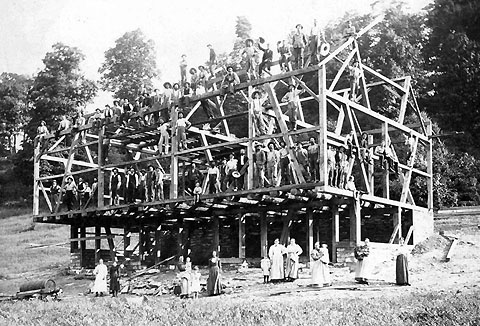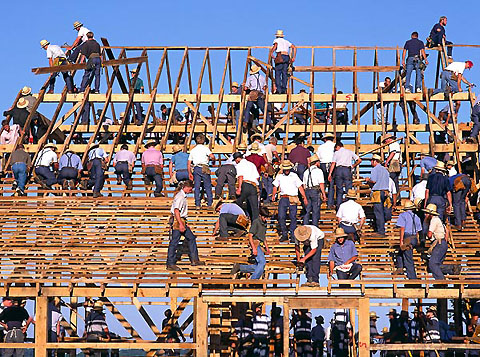A declaration of dependence
by Bill McKibben in the April 2008 issue of Orion Magazine
Cheap fossil fuel has made us what we are. Which is to say: rich, powerful—Look at us! We can make the ice caps melt! The oceans rise! But something else too: cheap fossil fuel has made us the first people on Earth with no need of our neighbors. Think, in the course of an ordinary day, how often you rely on the people who live near you for anything of practical value. Perhaps carpooling your kids to school or soccer. If you live in a rural community, there may
be a volunteer fire department, which keeps your insurance affordable. But your food, your fuel, your shelter, your clothes, and your entertainment most likely come from a distance and arrive anonymously at that. A meteorite could fall on your cul-de-sac tomorrow, disappearing your neighbors, and the routines of your daily life wouldn’t change.
Now imagine how different things have been for almost all of human history. Two hundred years ago, if an American wanted to eat a hamburger for dinner, he needed to be able to convince his neighbors to, say, help him build a barn in which to store hay to feed his cows all winter. And to help him harvest his wheat crop. Likely they would have come together to thresh it—there wasn’t a surplus of machinery. A neighbor would have slaughtered the cow and another
would have baked the bread, unless it was all done in the family. The same went for what was considered women’s work.
Laurel Thatcher Ulrich, in a wonderful article in the journal Feminist Studies, showed that our notion of the self-sufficient farm family was bunk. There was a lot more to do than just berrying or washing or husking or quilting. Say you needed some homespun woolen cloth: there were eleven separate tasks involved, from herding sheep to dressing the fabric, and, as Ulrich noted, “it would have been an extremely
unusual family that commanded the tools, skills, and labor to perform all of these steps at home. . . . What was true of wool was also true of flax,” she said, “for a family might grow its own; have it retted, swingled, and hackled by a flax dresser; bring it home for spinning and reeling; send it out to be woven; and then consign it to the bleach fields or dyer for finishing.”
Some of this exchange might have been paid for, much of it bartered, and a lot of it simply unaccounted for, since the reciprocal hand-lending was inevitable. Douglas Harper, in Changing Works, a poignant account of the dairy farms of northern New York, interviews farmers old enough to recall the time when “we would pitch in and go help. Everyone wasn’t so busy then. Oh, they had time or something.” You can read about it in Wendell Berry novels; if
you want to still see it in operation, you may need to visit an Amish farm.
That’s because the advent of cheap fossil fuel, and the prosperity, globalization, and specialization it allowed, changed, well, everything for those who went along (which is to say, everyone but the Amish). You could look at almost any profession—baker to banker—but let’s stick with farming. When you depended on horsepower and human labor, you needed help. When you depended on high-powered machinery, you simply didn’t. Once you had a big
combine, you could do it yourself. As one farmer told Harper, all of a sudden “there was no need, no call, really, to go see them. . . . I don’t think anyone has anything against anyone—you just don’t have any need to be there.” And all those machines let farms grow steadily bigger, which had as its logical result a far greater physical distance between the farm families who remained.
We could count this as simply the way of the world except for two problems.
One, of course, is that the era of cheap fossil fuel may be coming to an end, either because we run out or because we take global warming seriously and seriously cut back. Either way, the massive, invisible, industrialized methods we’ve come to rely on for feeding and clothing and fueling our lives may start to break down.
And the other problem is that we may break down. We weren’t designed to be this distant from our neighbors—we descend from apes who spend most of the day grooming each other for the practical purpose of removing lice and for the even more practical purpose of building the deep bonds that give their lives security and meaning. The economic life of Homo sapiens has always been about that kind of contact—until now, until us. Research has shown that when
we live on car-filled streets, our number of close friends drops by half. We eat half the meals we used to with friends, family, neighbors. Forget about the flax-swingler; our clothes come through the ether from the mysterious geography of Lands’ End. We don’t need each other anymore, and that’s the saddest thing we’ve done—sadder even than the scourge of climate change, which at
least is anonymous and impersonal.
Once we’ve started down this road, it’s hard to turn back; being a neighbor is a skill like any other, and it’s a skill we’ve increasingly lost as we’ve turned into hyperindividuals. Say you need the proverbial cup of sugar: do you turn to the neighbor or turn the car on and drive to the store? One survey found that three-quarters of Americans didn’t have a real relationship with the folks who lived next door. (New upscale houses
now routinely come with dual master bedrooms, since even the talent for being a mate seems to be dwindling.) The big question for this century may turn out to be how fast we can relearn the skill of neighborliness.
Take farming again. The local food movement is helping to build demand for small farms. If it continues, we may someday reach the point where we once again have more farmers than prisoners in America—which will be a good thing, if we’re hoping to grow our food with less oil. But if that’s going to happen, it will take more than farmers’ markets—it will take farming communities, with enough small growers in the neighborhood to teach each
other what needs doing. One of the best young farmers in my corner of Vermont, Spencer Blackwell, recently graduated from several seasons of growing grain and beans on the Intervale land in Burlington—a kind of incubator for young farmers with a dozen little start-up farms in any given year.
“Maybe it was a little bit what it was like in the 1800s, when every other person was a farmer,” he says. “You need to know something—what’s the best time to plant oats as a winter cover crop—and there’s someone right around to tell you.” You can borrow equipment too, which is helpful because, as Blackwell points out, almost everything at the implement dealer is designed
for mammoth farms. “I don’t want to grow a thousand acres of broccoli—I want to grow five acres,” he says.
For the rest of us, who aren’t planning to actually till the soil ourselves, relearning neighborliness means joining a CSA or going to the farmers’ market (where shoppers have ten times as many conversations per visit as they do at the Shop ‘n Save).
It means putting solar panels on our roofs and tying them into the grid so that our neighbors can cool their beer with the sunlight that falls on our shingles—and, of course, it means buying that beer from the local brewery. It means buying CDs when the artist is selling them after a concert, and listening to your local public radio station instead of the XM satellite-from-nowhere. It means not just supporting the idea of mass transit but getting on the darned
bus sometimes.
It means embracing nonindependence—which to us may seem un-American, but in fact it is just the opposite. Tocqueville, in the greatest clichè of American political science history, called us a nation of joiners. We’ve gotten away from that—become a nation of drive-around-by-ourselfers. But in a world that seems likely to grow a little tougher all around, with weird weather, rising prices, and falling profits, a neighbor is what you’ll
need most.

image above: Barn raising in Bakersville, PA, in 1908 at www.somersethistoricalcenter.org
|

